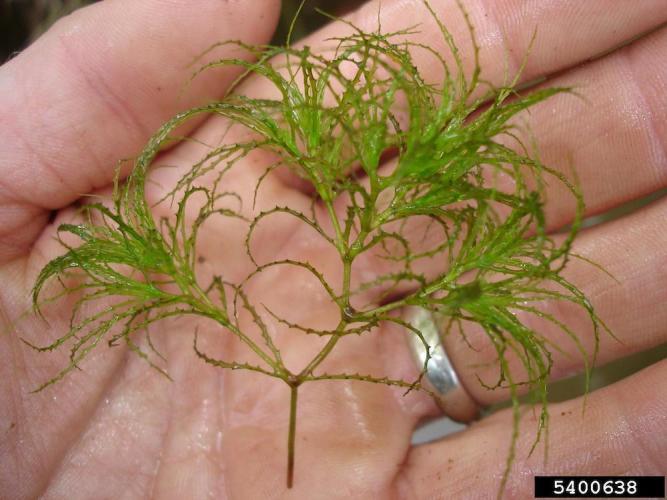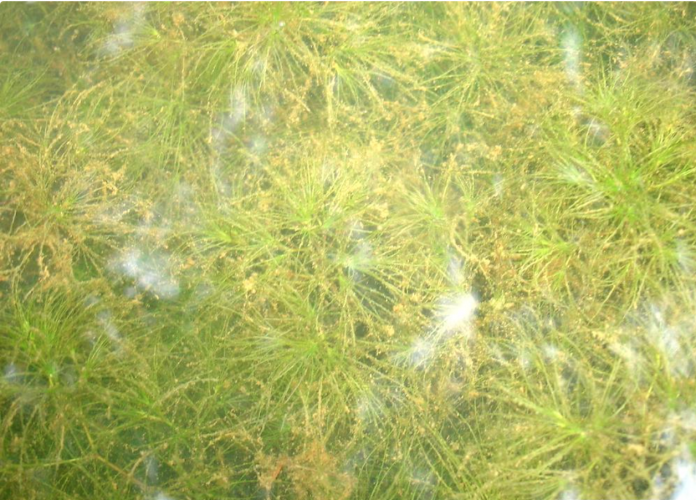Brittle Naiad
Identification
Brittle Naiad is a submersed or floating plant. This species typically appears to be compact and bushy, but can reach 1.2 meters in length. Slender, branching stems house opposite leaves that may appear whorled. Leaves are narrow (~1mm), range from 0.5 to 3.5 cm in length, and are typically clustered around leaf axils. Leaves are toothed and stiff, and are easily fragmented when manipulated. Flowers grow along leaf axils.
Biology
Origin
Europe and western Asia
Habitat
Brittle naiad prefers lentic (still water) systems such as ponds, lakes, and canals. It can grow in water up to 4 meters deep. Brittle naiad can tolerate turbid (cloudy) and eutrophic (excess nutrients) water conditions.
Ecological threat
Brittle naiad has been shown to inhibit native plant species’ growth by blocking sunlight during the early growing season, and outcompeting plants for resources such as space. Dense mats of brittle naiad can pose problems for fish and waterfowl. Death and decomposition of these mats can decrease oxygen availability in aquatic systems. A brittle naiad infestation can also limit the recreational potential of a water body.
Vermont Distribution
Brittle naiad has been confirmed in Rutland County, Waterbury Reservoir, Spectacle Pond (Brighton), and Lake Champlain.
How You Can Help
For most aquatic invasive species, humans are the primary vector of transport from one waterbody to another. Many of these nuisance plants and animals can be unknowingly carried on fishing gear, boating equipment, or in very small amounts of water in a watercraft. The easiest and most effective means to ensure that you are not moving aquatic invasives is to make sure that your vessel, as well as all your gear, is drained, clean, and dry.
BEFORE MOVING BOATS BETWEEN WATERBODIES:
-
CLEAN off any mud, plants, and animals from boat, trailer, motor and other equipment. Discard removed material in a trash receptacle or on high, dry ground where there is no danger of them washing into any water body.
-
DRAIN all water from boat, boat engine, and other equipment away from the water.
-
DRY anything that comes into contact with the water. Drying boat, trailer, and equipment in the sun for at least five days is recommended. If this is not possible, then rinse your boat, trailer parts, and other equipment with hot, high-pressure water.
INTERESTED IN MONITORING FOR AQUATIC INVASIVES?
- Join the VIPs! Vermont Invasive Patrollers help search for new infestations so we can respond immediately and prevent them from becoming established.
Citations
Haynes, R.R. 1979. Revision of North and Central American Najas (Najadaceae). Sida 8: 34-56.
http://dnr.state.mn.us/invasives/aquaticplants/brittlenaiad/index.html
Illinois-Indiana Sea Grant, 2017, Brittle waternymph: U.S. Geological Survey, Nonindigenous Aquatic Species Database, Gainesville, FL, and NOAA Great Lakes Aquatic Nonindigenous Species Information System, Ann Arbor, MI, https://nas.er.usgs.gov/queries/greatlakes/FactSheet.aspx?SpeciesID=111…, Revision Date: 9/25/2012, Access Date: 8/1/2017
Robinson, M. 2004. European naiad: An invasive aquatic plant (Najas minor). Massachusetts Department of Conservation and Recreation; Office of Water Resources; Lakes and Ponds Program. 4 pp.
Wentz, W. A. and R. L. Stuckey. 1971. The changing distribution of the genus Najas (Najadaceae) in Ohio. Ohio Journal of Science 71: 292-302.

